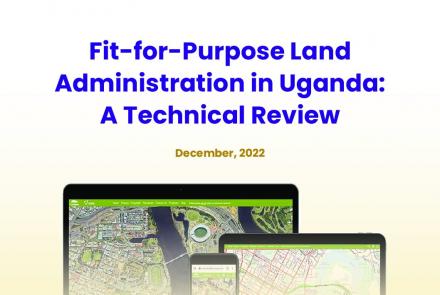Security of tenure for rural lands
Systematic adjudication and documentation of rights
In promoting and providing tenure security, LANDnet Uganda adopts a strategy of systematic demarcation on demand by communities. Adjudication and demarcation methods are to be piloted in a number of areas with the eventual aim of providing tenure security. The benefit of this approach is there is less danger of the poor being disposed and all rights are adjudicated simultaneously.
Improvement in land tenure security through land titling increases the collateral value of land there by communities gaining access to financial institutions for cheaper and long term credit which they can use to increase investment.
Registration of communal land associations under trusts:
Communal lands, especially in the northern Uganda, have become magnets for investors and local land grabbers because the large tracts are unutilized. To promote investment and productivity , while protecting the land rights of the local communities there is need to have the communal land associations formed and registered , have a common management scheme and provide technical advisory services to the communal land associations to enhance management capabilities of their land especially the management of transactions with in communities and with foreign investors.
Further there is no well-functioning transparent land sales and rental markets that can help transfer land in to the hands of who can use it efficiently and this has partly contributed to land grabbing of the communal lands.
Dispute resolution and conflict management
Land and natural resources can foster development, stability and livelihoods. But if mismanaged, they can contribute to negative outcomes such as deepening of poverty, corruption, erosion of state authority and control, destructive conflicts that can result into civil strife. Although land can never be the sole trigger of conflict, land conflicts commonly become violent when linked to wider processes of political exclusion, social discrimination, economic marginalization, and a perception that peaceful action is no longer a viable strategy for change. Land issues readily lend themselves to conflict because land is an important economic asset and a derivative of political power. It is also closely linked with community identity, history and culture. Communalities can therefore easily mobilize around land issues, making land a central subject of conflict around which communities can easily mobilize.
Land and the conflict over land-related resources, are increasingly becoming a driver of violence, instability and intra-state or cross border conflict, posing an increasing global challenge. This will only increase in the next decades due to the effects of climate change, food insecurity, limited natural resources and unsustainable urban growth. The assumption that land, and the conflict over land-related resources, are increasingly becoming a driver of violence, instability and intra-state or cross border conflict, posing an increasing global challenge is now a reality in Uganda.
The second dimension of conflicts arises from legal pluralism. Legal pluralism often is a source of conflict as one form of tenure, usually the registered lands tend to be more secure and operating in a market led economy and thus drawing more people especially the elite to individualize communal lands. The romaticization of registration of rights as delivering more security than the other forms of tenure has fueled conflicts in many jurisdictions resulting in mass evictions and land grabbing of the legitimate owners of land.
Conflicts can emerge during different phases of the conflict cycle:-
- During periods of relative stability, insecurity of tenure can be a source of latent grievance.
- During periods of insecurity, especially when land grievances are linked to broader conflict drivers, lack of land security may provoke violence and can lead to displacement of populations.
- During open conflict, large scale population displacement may lead to abandoned land being occupied either out of necessity or as a planned move to grab the land. This is because state and customary institutions have been weakened or may have even collapsed.
- During peace processes, there is a tendency for negotiators to focus on the political questions to the detriment of land issues, which can prove to be challenging in the long run. In the post conflict phase, conflicts over land tend to increase rather than decrease, as land allocations often proceed haphazardly in the insecure post-conflict environment.
Where the land administration system is not fully functional, marred by issues such as incomplete cadastres, tenure insecurity, fuzzy and incomplete land rights regimes, formal and informal failure of land dispute resolution and absence of conflict sensitive land governance approaches, the likelihood of land grievances turning into fully blown conflicts is high.
LANDnet takes cognizance of the fact that the management of land and natural resources is one of the most critical challenges facing developing countries today. The exploitation of high-value natural resources, including oil, gas, minerals and timber has often been cited as a key factor in triggering, escalating or sustaining violent conflicts around the globe. Furthermore, increasing competition over diminishing renewable resources, such as land and water, are on the rise. This is being further aggravated by environmental degradation, population growth and climate change. The mismanagement of land and natural resources is contributing to new conflicts and obstructing the peaceful resolution of existing ones.
To improve capacity for land and natural resource management (NRM) and conflict prevention, it is important to have efficient land administration systems that are not blind to the range of rights.
Conflicts over land can be resolved in two ways through the judicial system or through the administrative system.
- Judicial resolution of land conflicts comprises disputes or conflicts arising out of civil or criminal wrongs that have a cause of action with remedies granted by a court or informal dispute resolution system.
- Administrative conflict/dispute resolution comprises of disputes/conflicts arising out of the work and functioning of land rights administration and these disputes require administrative remedies.





